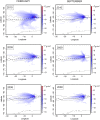Organic Compounds in a Sub-Antarctic Ice Core: A Potential Suite of Sea Ice Markers
- PMID: 31762520
- PMCID: PMC6853201
- DOI: 10.1029/2019GL084249
Organic Compounds in a Sub-Antarctic Ice Core: A Potential Suite of Sea Ice Markers
Abstract
Investigation of organic compounds in ice cores can potentially unlock a wealth of new information in these climate archives. We present results from the first ever ice core drilled on sub-Antarctic island Bouvet, representing a climatologically important but understudied region. We analyze a suite of novel and more familiar organic compounds in the ice core, alongside commonly measured ions. Methanesulfonic acid shows a significant, positive correlation to winter sea ice concentration, as does a fatty acid compound, oleic acid. Both may be sourced from spring phytoplankton blooms, which are larger following greater sea ice extent in the preceding winter. Oxalate, formate, and acetate are positively correlated to sea ice concentration in summer, but sources of these require further investigation. This study demonstrates the potential application of organic compounds from the marine biosphere in generating multiproxy sea ice records, which is critical in improving our understanding of past sea ice changes.
Keywords: Bouvet; biomarkers; ice core; sea ice; sub‐Antarctic.
©2019. The Authors.
Figures



References
-
- Abram, N. J. , Curran, M. A. J. , Mulvaney, R. , & Vance, T. (2008). The preservation of methanesulphonic acid in frozen ice‐core samples. Journal of Glaciology, 54(187), 680–684. 10.3189/002214308786570890 - DOI
-
- Abram, N. J. , Thomas, E. R. , McConnell, J. R. , Mulvaney, R. , Bracegirdle, T. J. , Sime, L. C. , & Aristarain, A. J. (2010). Ice core evidence for a 20th century decline of sea ice in the Bellingshausen Sea, Antarctica. Journal of Geophysical Research, 115, D23101 10.1029/2010JD014644 - DOI
-
- Abram, N. J. , Wolff, E. W. , & Curran, M. A. J. (2013). A review of sea ice proxy information from polar ice cores. Quaternary Science Reviews, 79, 168–183. 10.1016/j.quascirev.2013.01.011 - DOI
-
- Baboukas, E. D. , Kanakidou, M. , & Mihalopoulos, N. (2000). Carboxylic acids in gas and particulate phase above the Atlantic Ocean. Journal of Geophysical Research, 105(D11), 14,459–14,471. 10.1029/1999JD900977 - DOI
-
- Comiso, J. C. (2017). Bootstrap sea ice concentrations from Nimbus‐7 SMMR and DMSP SSM/I‐SSMIS , Version 3 [Indicate subset used]. Boulder, Colorado USA. NASA National Snow and Ice Data Center Distributed Active Archive Center. 10.5067/7Q8HCCWS4I0R - DOI
LinkOut - more resources
Full Text Sources
Miscellaneous
